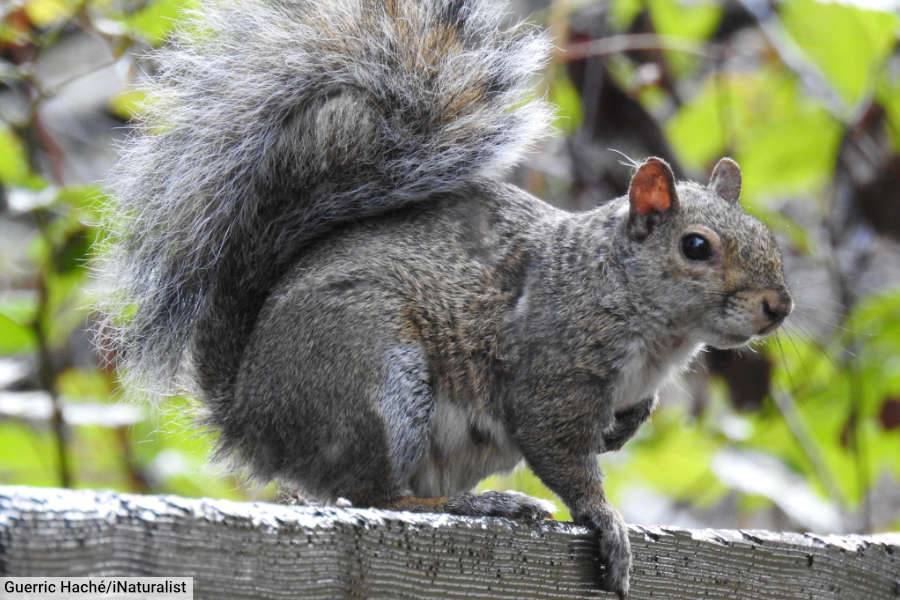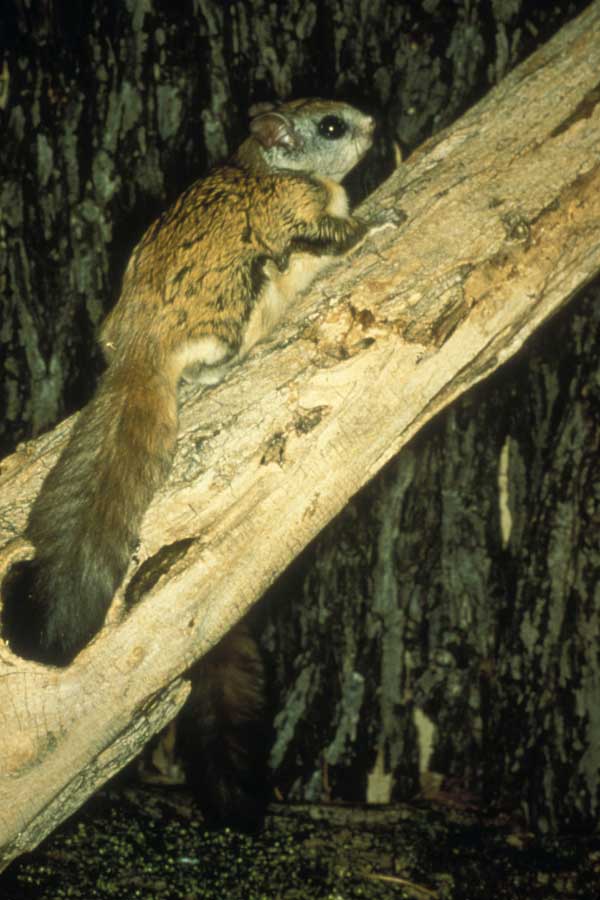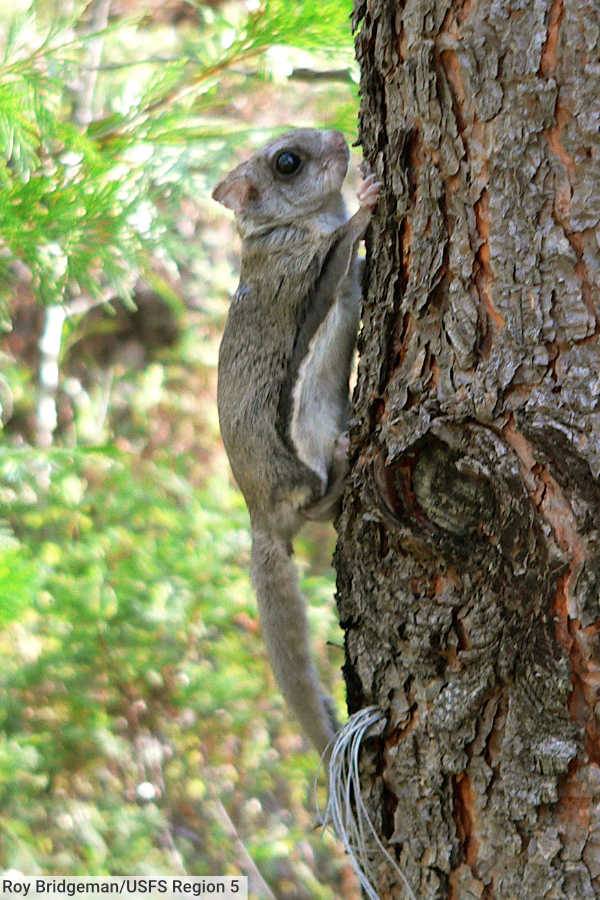
On this page is a list of common squirrel species found in North America.
Squirrels are rodents belonging to the squirrel family, Sciuridae. This family has several subfamilies, the most notable of these in North America being the tree squirrels (which includes the three species of flying squirrels found in North America), and the ground squirrels, a group that includes chipmunks and marmots.
You can find out more about the squirrel family and the different types of squirrels (including the cat-sized Oriental giant squirrels) further down the page.
Page Index
Squirrel Species – Common Types Of Squirrels Found In North America
Tree Squirrels
Tree squirrels are agile, medium-sized rodents known for their bushy tails and arboreal (tree-dwelling) lifestyles. Their sharp claws allow them to climb trees with ease. Their fur ranges from gray and brown to reddish hues, and they often have lighter undersides.
Tree squirrels are diurnal (active during the day), and primarily arboreal (tree-dwelling), though they often forage on the ground. Most are omnivorous, feeding on nuts, seeds, fruits, and occasionally insects, bird eggs and even small vertebrates.
Highly adaptable, tree squirrels build nests known as dreys in tree canopies and often bury excess food for nourishment during the winter.
Eastern Gray Squirrel

- Scientific name: Sciurus carolinensis
- Found: Eastern and Midwestern U.S., parts of Canada.
- Characteristics: Gray fur with a white underside, sometimes with a reddish tinge. Very adaptable, commonly found in urban and suburban areas.
The eastern gray squirrel is a medium-sized tree squirrel with gray fur, white underparts, and a bushy tail edged with white. Native to eastern North America, they thrive in forests, urban parks, and suburban areas.
These squirrels are diurnal and highly active, displaying remarkable agility in trees but frequently foraging on the ground for nuts, seeds and fruits. Known for their food caching behavior, they bury acorns and other items to retrieve during the winter. Social yet territorial, gray squirrels use vocalizations and tail flicks to communicate.
The eastern gray squirrel has been introduced to other parts of the world. In England, it has almost entirely displaced the smaller, native red squirrel.
Western Gray Squirrel

- Scientific name: Sciurus griseus
- Found: Western U.S., including California, Oregon, and Washington.
- Characteristics: Silvery gray fur with a white underside, native to oak and pine forests.
The western gray squirrel is a large, tree-dwelling rodent native to the forests of western North America. It has striking silver-gray fur, a white belly, and an impressively bushy tail, often longer and fuller than that of the Eastern Gray Squirrel.
Western Gray Squirrels are shyer and more elusive than their eastern cousins, favoring oak woodlands and coniferous forests over urban areas. They primarily feed on acorns and pine seeds, and will cache food for later consumption.
Unlike the adaptable eastern gray squirrel, western gray squirrels are less tolerant of human presence and habitat changes, leading to a more restricted range and conservation concerns.
When threatened, the western gray squirrel emits a loud chirping call, often prompting other nearby squirrels to join in and amplify the alarm.
Fox Squirrel

- Scientific name: Sciurus niger
- Found: Eastern and Central U.S., as well as parts of the West.
- Characteristics: Larger than the Eastern Gray Squirrel, with orange-brown fur. Prefers open forests and wooded areas.
The fox squirrel is the largest tree squirrel in North America. Throughout most of its range, it has gray or reddish-brown fur with pale orange undersides. However, some populations (e.g. those found in the Appalachians) have a grayish coat with darker accents, and some may be almost entirely black.
Preferring open woodlands, parks, and suburban areas, Fox Squirrels are diurnal and primarily ground-foraging, feeding on nuts, seeds, fruits, bird eggs and fungi. They build large leaf nests (dreys) or den in tree cavities, and are less territorial than other North American squirrels.
Compared to the smaller Eastern Gray Squirrel, Fox Squirrels are more robust, with less gray in their coat and slower, deliberate movements.
Red Squirrel

- Scientific name: Tamiasciurus hudsonicus
- Found: Throughout Canada, the northeastern U.S., and the Rocky Mountains.
- Characteristics: Small, with reddish fur. Often found in coniferous forests and very territorial.
The red squirrel (also known as the American red squirrel to differentiate it from the Eurasian red squirrel) is a small, lively tree squirrel distinguished by its reddish-brown fur, white underbelly, and a bushy tail often edged with darker tones. Its small size, more vivid coat, and affinity for dense evergreen habitats are other aids to identification.
Found in coniferous forests across North America, the red squirrel is solitary and highly territorial. It is known for its loud, chattering vocalizations. It feeds mainly on conifer seeds, and it is a prolific hoarder, creating food caches for winter.
Ground Squirrels
Ground squirrels are small to medium-sized rodents known for their burrowing lifestyle. They typically have slender bodies, short legs, and less bushy tails compared to tree squirrels. Their fur ranges from gray and brown to patterned coats with stripes or spots, such as in chipmunks.
Ground squirrels inhabit grasslands, deserts, and open woodlands, where they dig extensive burrow systems used for shelter, storing food, and raising young. Diurnal and social, they live in colonies and communicate through vocalizations and tail signals.
Ground squirrels are omnivorous, eating seeds, nuts, fruits, and insects. Their burrowing activities play a vital role in soil aeration.
California Ground Squirrel

- Scientific name: Otospermophilus beecheyi
- Found: California and parts of Oregon, Nevada, and Washington.
- Characteristics: Brownish-gray fur with white markings, often seen in meadows, fields, and suburban areas.
The California ground squirrel is a medium-sized rodent with a mottled or speckled grayish-brown coat, a speckled back, and a bushy tail similar to tree squirrels but less full. It is a common sight in California and Oregon, and may also be seen in Nevada and Washington.
The California ground squirrel typically inhabits grasslands, rocky outcrops, and agricultural areas. This diurnal (active during the day) squirrel is a prolific digger, creating intricate burrow systems for shelter and storage.
The species is mainly herbivorous, feeding on seeds, nuts and fruits. Unlike tree squirrels, it spends most of its time on the ground and lacks their climbing ability.
Thirteen-lined Ground Squirrel

- Scientific name: Ictidomys tridecemlineatus
- Found: Central U.S. and southern Canada.
- Characteristics: Brown with 13 white stripes down its back, prefers grassy areas and prairies.
The thirteen-lined ground squirrel is a small, sleek rodent named for the alternating light and dark stripes running along its back and sides, some dotted with small spots.
Native to North American prairies and grasslands, the thirteen-lined ground squirrel has a slim build, short legs, and a less bushy tail than tree squirrels.
This diurnal species lives in burrows, often in open, sunny areas, and feeds on seeds, grasses, insects, and small vertebrates. It is known to hibernate for over six months of the year, from autumn to spring.
Rock Squirrel

- Scientific name: Otospermophilus variegatus
- Found: Southwestern U.S. and Mexico.
- Characteristics: Large for a ground squirrel, with mottled gray and brown fur, often seen in rocky areas.
The rock squirrel is a large ground squirrel with a robust build and a mottled / speckled gray-brown coat, sometimes with a blackish appearance. Its bushy tail resembles that of a tree squirrel but is shorter and less refined.
Native to rocky areas, canyons, and arid habitats in the southwestern United States and Mexico, the rock squirrel digs extensive burrows or uses natural crevices for shelter.
Rock Squirrels are primarily herbivorous, consuming seeds, nuts, fruits, and insects. Their preference for rocky environments distinguishes them from other species.
Flying Squirrels
North America is home to three species of flying squirrels, all belonging to the genus Glaucomys. These nocturnal rodents are characterized by soft, silky fur, large dark eyes for enhanced night vision, and a skin membrane (patagium) stretching from wrist to ankle, allowing them to glide between trees.
Flying squirrels inhabit forests and woodlands, where they feed on nuts, seeds, fungi, and insects. They communicate with high-pitched chirps.
These species are elusive and often overlooked due to their nocturnal habits, but they play crucial ecological roles as seed dispersers.
- You can find out more about flying squirrels on this page: Flying Squirrels Facts
Southern Flying Squirrel

- Scientific name: Glaucomys volans
- Found in the eastern United States, parts of southeastern Canada, and Central America.
- Small in size, with grayish-brown fur, a white belly, and large, dark eyes adapted for night vision.
- Prefers deciduous and mixed forests and is known for its social and vocal nature.
Northern Flying Squirrel

- Scientific name: Glaucomys sabrinus
- Found in the northern United States, Canada, and parts of the Rocky Mountains and Appalachian regions.
- Slightly larger than the southern flying squirrel, with brown fur, a grayish belly, and a less pronounced color contrast between its back and underside.
- Inhabits coniferous and mixed forests and has a diet that includes fungi, lichens, and nuts.
Humboldt’s Flying Squirrel

- Scientific name: Glaucomys oregonensis
- Humboldt’s Flying Squirrel is closely related to the northern flying squirrel, and was only recognized as a distinct species in 2017.
- Found in the Pacific Coast regions of the United States and Canada, overlapping with the northern flying squirrel’s range.
- Similar in appearance to the northern flying squirrel but genetically distinct.
What Is A Squirrel?
Squirrels are rodents belonging to the squirrel family, Sciuridae. This diverse group encompasses over 200 species worldwide, with over sixty species calling North America home.
As well as the familiar, bushy-tailed tree squirrels, the squirrel family also includes animals that are more at home on the ground, such as chipmunks, prairie dogs and marmots.
The squirrel family is divided into several subfamilies (listed below), with the most notable in North America being tree squirrels, ground squirrels, and flying squirrels.
Despite their differences, all squirrels share key traits such as sharp incisors for gnawing and bushy tails that aid in balance and communication.
Types Of Squirrels
Subfamily Sciurinae (Tree Squirrels and Flying Squirrels)
This subfamily includes tree-dwelling and gliding squirrels, which are the most familiar to many people.
- Tree squirrels (Sciurini): Examples include the eastern gray squirrel (Sciurus carolinensis), fox squirrel (Sciurus niger), and red squirrel (Tamiasciurus hudsonicus).
- Flying squirrels (Pteromyini): Gliding species such as the northern flying squirrel (Glaucomys sabrinus) and southern flying squirrel (Glaucomys volans).
Subfamily Xerinae (Ground Squirrels and Marmots)
This subfamily comprises ground-dwelling species, including ground squirrels, prairie dogs, and marmots.
Key groups:
- Ground squirrels (Marmotini): Includes chipmunks, prairie dogs, and ground squirrels like the California ground squirrel (Otospermophilus beecheyi).
- Marmots (Marmota): Larger burrowing species such as the woodchuck (Marmota monax) and yellow-bellied marmot (Marmota flaviventris).
Subfamily Callosciurinae (Exotic Squirrels, or “Beautiful” Squirrels)
This subfamily primarily consists of species found in Asia and tropical regions. While not native to North America, some species, such as the Finlayson’s squirrel (Callosciurus finlaysonii), have been introduced in certain areas.
Subfamily Ratufinae (Oriental Giant Squirrels)

This squirrel subfamily contains four species of very large squirrels. They are found in the forests and woodlands of south and southeast Asia.
Subfamily Sciurillinae (Neotropical Pygmy Squirrel)
This subfamily contains just one species, the neotropical pygmy squirrel, which is found in rainforests in South America. It is the smallest tree-dwelling squirrel of the Americas.
Further Reading – Discover More With Active Wild
Visit our main animals page for links to animal information and a complete guide to the animal kingdom: Animals
You can find out more about rodents on this page: Rodents – The Ultimate Guide
The post Different Types Of Squirrels Found in North America With Pictures appeared first on Active Wild.